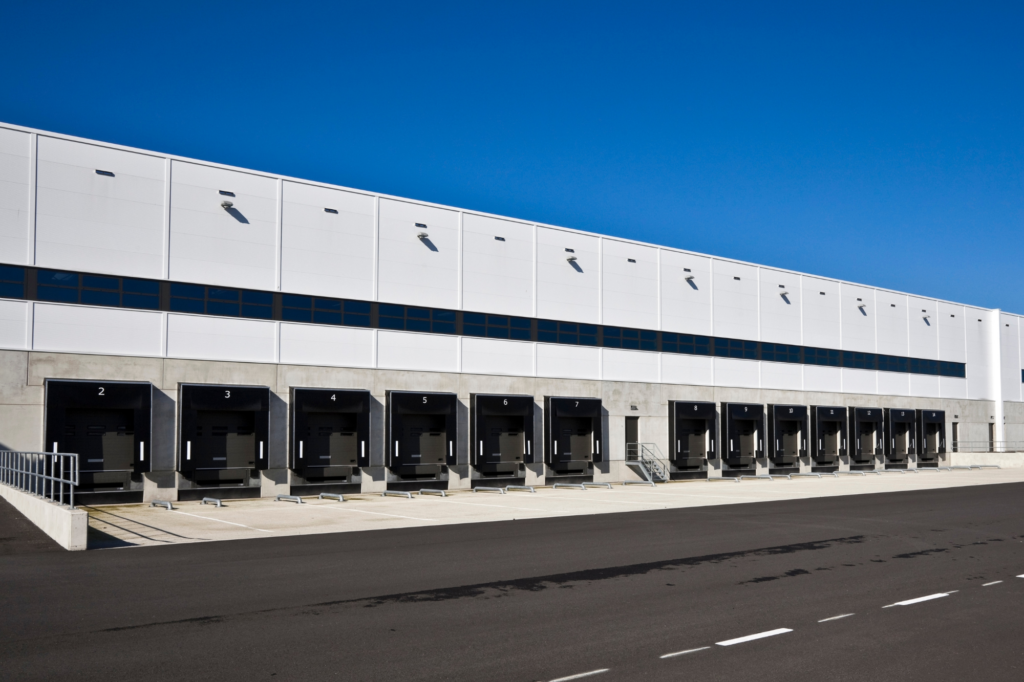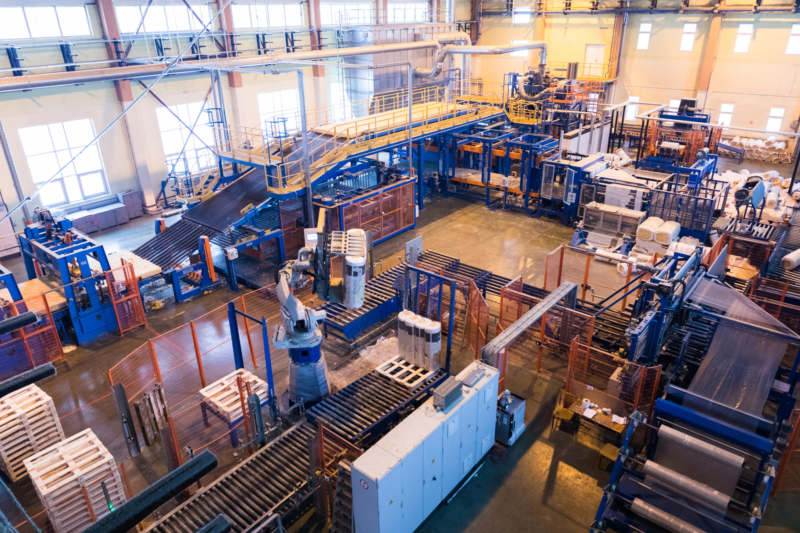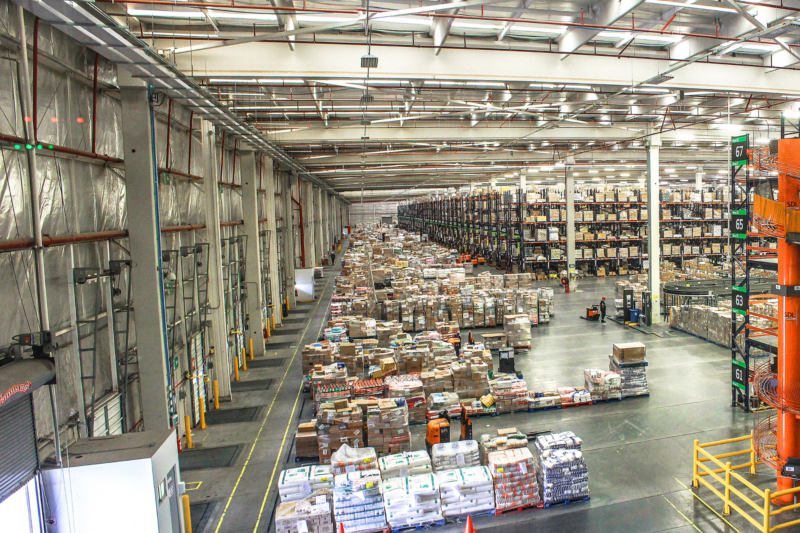
What Are Industrial Properties?
Industrial properties are facilities and land dedicated to industrial activities that produce, store, and ship goods. Common functions of industrial properties include manufacturing, product assembly, storage, distribution, transpiration, and research. Almost every good and product found in the typical household or office was produced, stored, and shipped through various industrial properties.
Industrial properties are typically located outside of major cities and urban areas near airports, seaports, and major transportation hubs. Unlike other property types, such as office buildings, industrial properties serve a wide range of functions. As a result they come in all shapes and sizes. This is why a luxury car dealer’s showroom and a manufacturing plant making EV charging stations are both technically considered industrial properties. Continue reading to learn more about the various types of industrial properties and their defining characteristics.
Types Of Industrial Properties
There are 8 main types of industrial properties that fall under 3 categories. Each category contains properties that serve similar functions in developing, producing, shipping, and storing goods. The 3 categories of industrial properties are:
- Manufacturing
- Storage and Distribution
- Flex Space
Industrial properties in each category are defined by characteristics ranging from square footage and loading dock size to electrical systems and equipment capacity. The 8 types of industrial properties include:
- Heavy Manufacturing
- Light Assembly
- Distribution Center
- General Warehouse
- Truck Terminal
- Research and Development
- Data Center
- Showroom
Many industrial properties serve more than one function. A company could use one large facility to assemble and distribute products. The same industrial building could have space where they research product improvements. When an industrial property serves multiple functions, it is typically defined by the dominant function. The example industrial building in this scenario would be categorized as a light assembly manufacturing property because that is the primary function.
Manufacturing Industrial Properties

What Are Manufacturing Industrial Properties?
There are two types of industrial manufacturing properties; heavy manufacturing and light assembly. Both types of industrial manufacturing properties are defined by having less than 20% office space and a loading dock for trucks with clear heights of at least 10 feet. In general, raw goods, like steel, are produced in heavy manufacturing facilities while final products, like televisions, are produced in light assembly facilities.
1. Heavy Manufacturing Properties
Heavy manufacturing properties are typically large spaces, often over 100,000 square feet, with significant amounts of usable space. This space is typically filled with permanently installed heavy duty manufacturing equipment. Heavy manufacturing properties offer three phase electricity necessary to power manufacturing equipment. Changing tenants in a heavy manufacturing facility typically requires a total building renovation due to the nature of the equipment.
Examples of goods produced in heavy manufacturing properties include steel, automobiles, commercial ships, and rockets.
2. Light Assembly Properties
Light assembly properties, also referred to as light manufacturing, tend be smaller and less customized than heavy manufacturing facilities. Equipment inside light assembly facilities is usually lighter and more portable due to the nature of goods being produced. As a result, it is easier for tenants to move in and out of light assembly properties.
Goods produced in light assembly properties frequently use components produced in other facilities. Examples of goods produced in light assembly facilities include circuit boards, small appliances, toys, and shoes.
Storage and Distribution Industrial Properties

What Are Storage and Distribution Industrial Properties?
Storage and distribution is the next industrial property category. This category contains three types of properties; distribution warehouses, general warehouses, and truck terminals. All of these facilities are involved in the movement of manufactured goods. While these three industrial properties serve different functions, they are commonly defined by having at least 80% of space dedicated to storage of goods.
1. Distribution Warehouse
Distribution warehouses, or distribution centers, are primarily used to ship goods to end users. This is why they are frequently located near airports and major shipping lanes. Goods are not meant to sit for extended periods of time inside distribution warehouses. They are typically over 100,000 square feet and designed to accommodate forklifts and large storage racks.
When consumers order products online from retailers such as Amazon or Nike, it typically arrives from a distribution center.
2. General Warehouse
When companies need to store goods and products for extended periods of time, they need a general warehouse. These are large facilities that can easily surpass 100,000 square feet. Goods stored inside general warehouses are typically easy to handle, already packaged, and do not require a controlled environment.
Examples of goods stored in general warehouses can range from canned food and clothing to automobile parts and raw materials.
3. Truck Terminal
While they are categorized under storage and distribution, truck terminals do not typically store goods for long periods of time. This is because they are 100% devoted to transportation. Truck terminals are places where goods are transferred from one truck to another. The transfer of goods from incoming trucks to outgoing trucks typically takes place as fast as possible. As a result, truck terminals typically have little to no space available to store goods.
All types of goods pass through truck terminals. If a good is transported on a truck, chances are high it passed through a terminal.
Flex Space Industrial Properties

What Are Flex Space Industrial Properties?
Flex spaces take on many shapes, sizes, and functions. This makes them different from manufacturing and storage and distribution industrial properties which are all centered around a similar function. Another key difference between flex spaces and other industrial properties is the layout of interior spaces. As a rule of thumb, more than 30% of an industrial flex property’s square footage is dedicated to office space.
1. Research and Development
When companies are looking to create new products or technologies, they need research and development space. Commonly abbreviated to “R&D”, the inside of research and development facilities offers a wide variety of spaces and functions. These spaces commonly include laboratories, office, testing areas, storage areas, manufacturing floors, and other areas dedicated to development and testing of new products.
An example of a research and development facility is a car manufacturer using crash dummies to test new safety restraints and airbags.
2. Data Centers
Data centers serve the most straightforward purpose among flex industrial properties. They contain servers and other hardware that securely store critical data for companies and/or individuals. They are frequently bigger than 100,000 square feet. Most data centers require significant electrical, mechanical, and security systems. As a result, industrial property managers can specialize in managing and running data centers.
3. Showrooms
The final type of industrial flex space is a showroom. Frequently, at least 50% of showroom space is reserved for showcasing products. Similar to other flex spaces, they usually large buildings that include significant amounts of office space. Many showrooms will also include warehouse space for storing products.
If you’ve ever bought a new car from a dealership, you’ve been inside an industrial showroom property.
Find Contractors Using BidSource
Property managers can use BidSource to have our team find a contractor ready to assist with your next project. Share your project details using the form below and our team will be in touch with a qualified contractor!

Aaron Hockel is a Partner and the VP of Digital Marketing at AltaVista Strategic Partners. A University of Maryland, Baltimore County (UMBC) alumnus, Aaron expertly crafts digital marketing strategies that drive success for clients, leveraging his deep industry knowledge and innovative approach.


